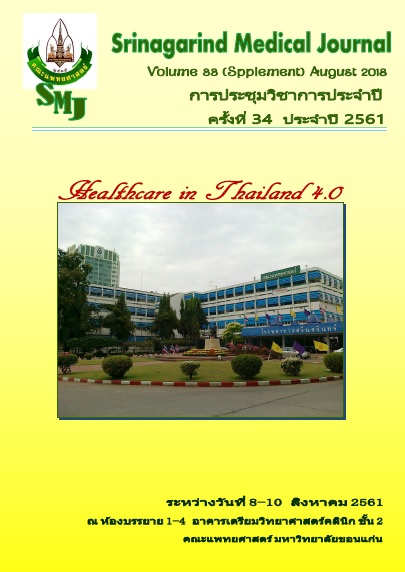Blood Components Logistics Solution in Srinagarind Hospital, Faculty of Medicine, Khon Kaen University, Thailand
Keywords:
Logistics; Blood componentsAbstract
Background and Objective; Over view of blood components for transfer to wards more than 80,000 units per year. Then the blood transfusion committee plan to re-arrange blood components logistics in Srinagarind hospital, Khon Kaen university. The aims of this study were to evaluate T/T (transferred per transfused rate) ratio compare with C/T (cross-matched and transfused) ratio, to control the proper temperature between transferring process and to evaluate the satisfaction rate of the staffs at ward who used our services.
Method; Time of logistics transferring was designed to 7 times per day. The information of types of blood components and number of requesting were collected from August to December, 2016. All data collected to Excel for calculate T/T ratio. The temperature was monitored every times of transferring. The satisfaction was sent to ward for evaluated.
Result: Total of red blood cell concentrates and plasma were requested 6,545 units. (Red blood cell concentrates 4,287 units/plasma 2,258 units). The T/T ratio of logistics blood components transferring of red blood cells concentrates and plasma were 1.23 and 1.04, respectively and compared to the C / T ratio of the two blood components were 1.6 and 1.8, respectively. The temperature between transferring process was 2-10 degree Celsius. The satisfaction rate was 95%.
Conclusion; The blood components logistics can reduce the C/T ratio; the time of this study T/T ratio was 1.23 (C/T =1.6; 2016). It can reduces the units supply and we can make sure the temperature for transferring is safe for quality of red blood cells concentrates. Also, the satisfaction rate is highly response.
References
2. Vamvakas EC, Blajchman MA. Transfusion-related mortality: the ongoing risks of allogeneic blood transfusion and the available strategies for their prevention. Blood 2009; 113: 3406–17.
3. Anderson NL. The clinical plasma proteome: a survey of clinical assays for proteins in plasma and serum. Clin Chem 2010; 56: 177-85.
4. Kreutziger J, Schlaepfer J, Wenzel V, Constantinescu MA. The role of admission blood glucose in outcome prediction of surviving patients with multiple injuries. J Trauma 2009; 67: 704–8.
5. Douay L, Andreu G. Ex vivo production of human red blood cells from hematopoietic stem cells: what is the future in transfusion? Transfus Med Rev 2007; 21: 91–100.
6. Armand R, Hess JR. Treating coagulopathy in trauma patients. Transfus Med Rev 2003; 17: 223–31.
7. Shuja F, Shults C, Duggan M, Tabbara M, Butt MU, Fischer TH, et al. Development and testing of freeze-dried plasma for the treatment of trauma-associated coagulopathy. J Trauma 2008; 65: 975–85.




